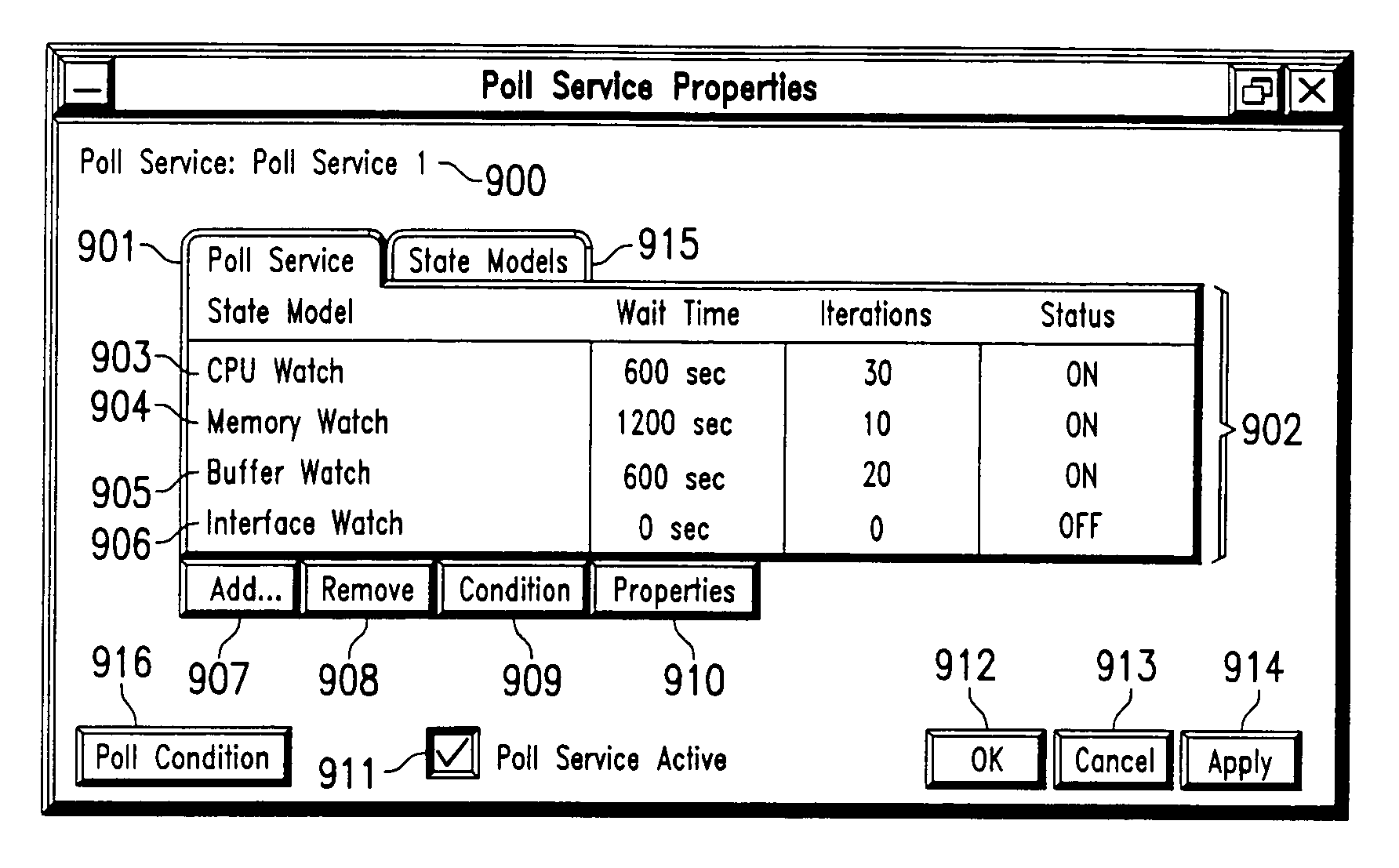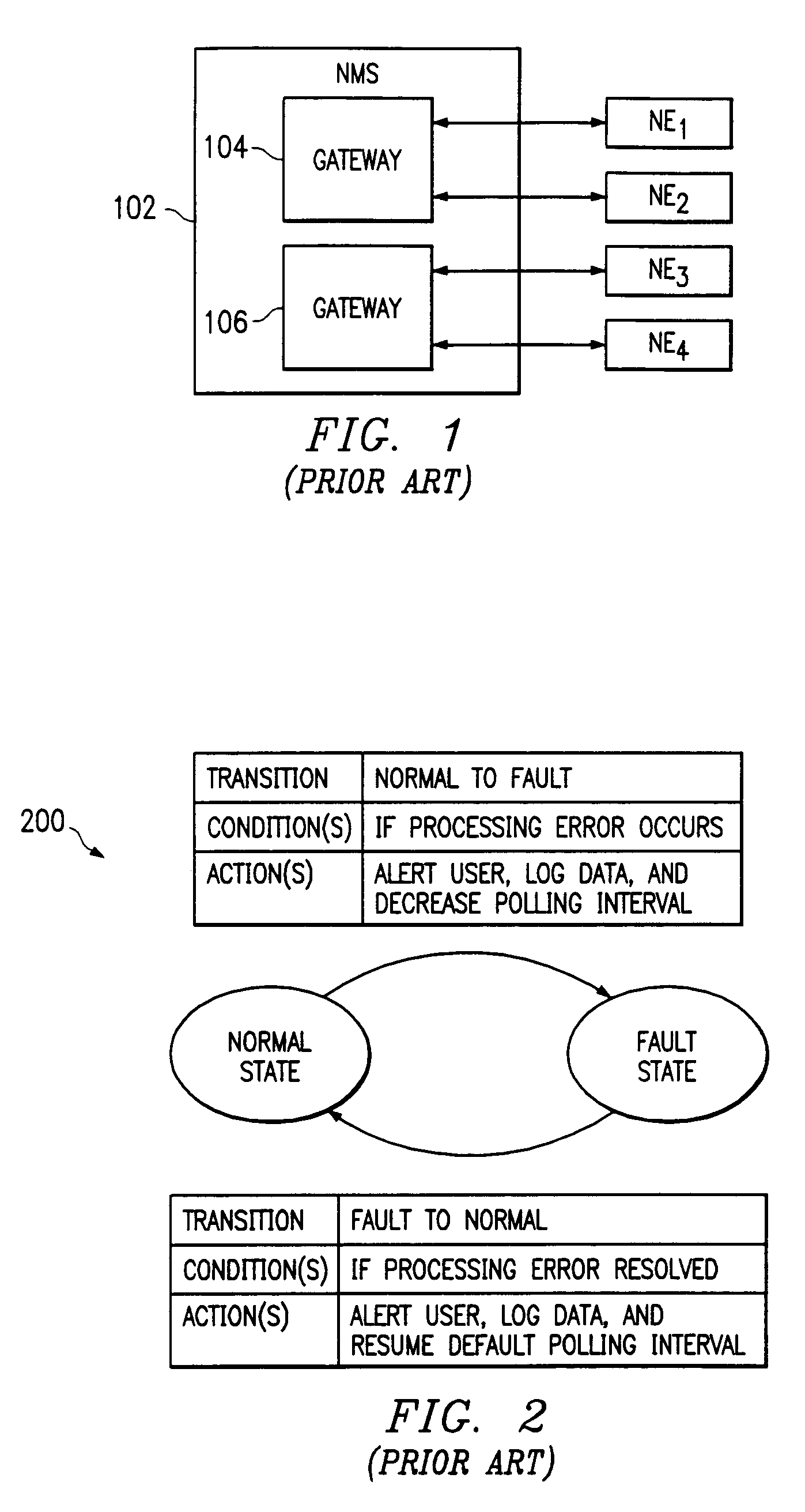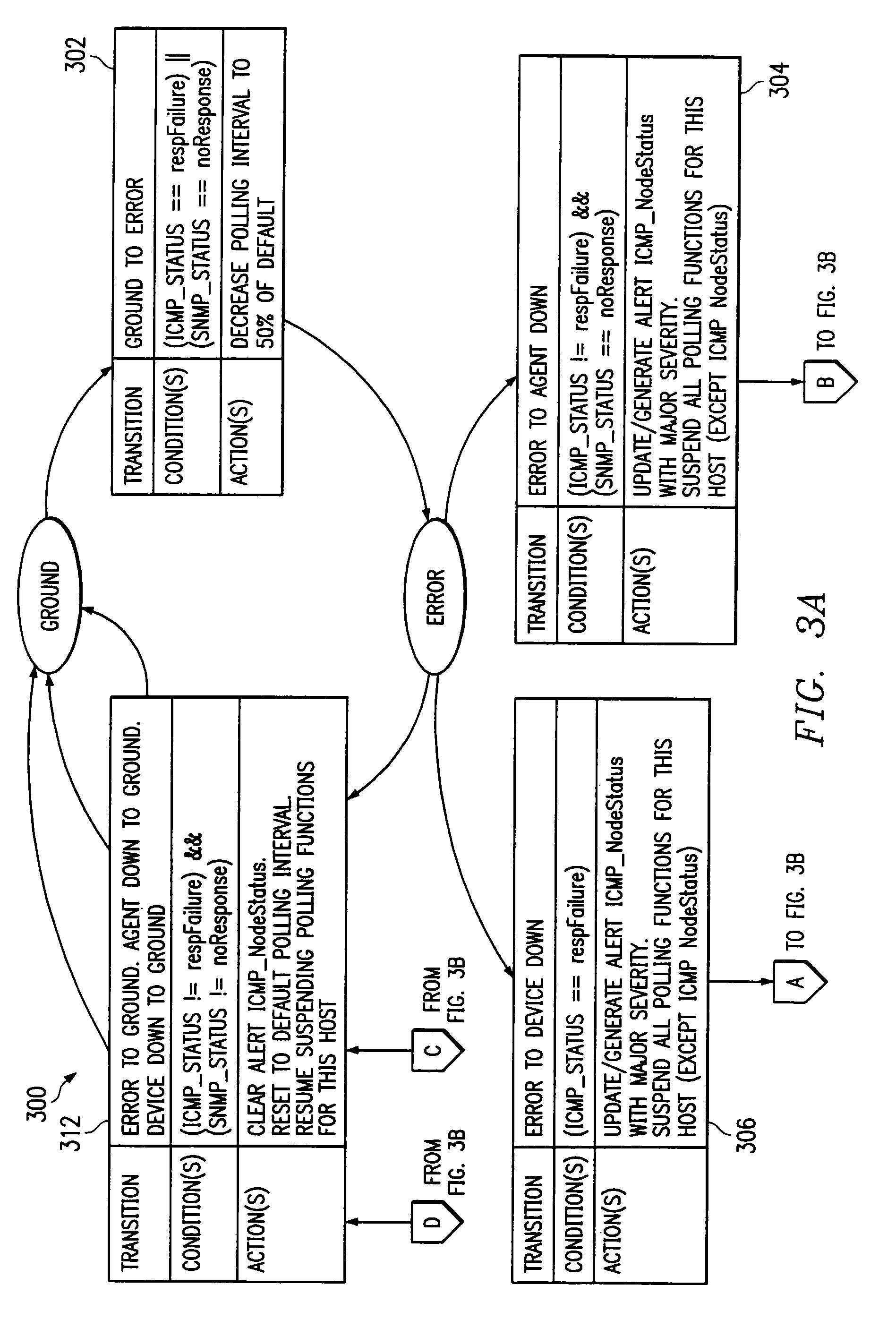However, such NMSs / OSSs are generally based on older technologies, which poorly integrate disparate network elements and associated
Element Management Systems (EMSs).
Many other companies use other types of EMSs, NMSs and OSSs that are not scalable, cannot be easily interfaced with disparate network elements, and require costly
programming while offering limited features and flexibility.
That is, while a polling gateway of the prior art may allow a user to manually adjust its polling interval, prior art gateways do not autonomously modify their polling intervals based on the performance of their respective network elements.
If a
network element fails to respond to such a poll, such failure to respond may be indicative of a problem with the
network element, such as the network element having a hardware or
software failure.
Gateways of the prior art typically do not correlate various polls that they perform on one or more network elements, and therefore typically lack an intelligent understanding as to the operation of such network elements.
However, because the polling processes are not correlated in prior art systems, the gateway would continue to periodically poll for the CPU memory buffer even though another polling process has determined that the network element is not responsive.
Therefore, prior art gateways are typically implemented with very little intelligence, and do not correlate various polled conditions of network elements to obtain an intelligent view of the overall condition of the network elements.
As a result, a great operational burden is placed on the NMS 102 because all of the poll responses and gateway
processing is included within the NMS 102.
That is, state-based polling has traditionally not been performed in prior art
network management systems.
While the above-described state-based polling has been proposed in the prior art, prior art polling systems, including such state-based
polling system, have many problems and / or shortcomings.
While NMS systems that include polling gateways may be implemented at a variety of different locations throughout network(s) in the prior art, such NMS systems are typically not implemented such that they are in communication with each other or with a common
central management system (MS).
Because prior art management systems typically utilize a plurality of stand-alone NMS systems,
software code for controlling the polling gateways at each NMS system (such as
software code for implementing state-based polling) must be written, installed, and maintained on each independent NMS system, which is often burdensome to system administrators in implementing and maintaining each independent NMS system operating in a desired manner.
Furthermore, because the polling gateways of prior art systems are not distributed, but are instead implemented local to or integrated within the NMS system, the
processing requirements placed on the NMS system and communication traffic between the network elements and the NMS system become undesirably high.
For example, in FIG. 1, NMS 102 communicates with a plurality of network elements (e.g., NE1-NE4), which results in an undesirably large amount of communication traffic therebetween.
This is particularly problematic considering that many of the network elements being monitored by the NMS may be located a long distance away from such NMS, which may result in increased costs (e.g., due to long-distance communication charges) for the NMS.
Additionally, such communication traffic between the NMS and the monitored network elements undesirably ties up communication resources (e.g., communication lines), thereby reducing the amount of bandwidth available to others desiring to communicate utilizing such communication resources.
Thus, such polling may result in undesirable traffic across
the Internet, thereby negatively effecting the ability of other users attempting to communicate via
the Internet.
Additionally, the architecture utilized for implementing traditional NMSs, including polling gateways, of the prior art are burdensome on system administrators desiring to customize the operation of such NMSs.
More specifically, such prior art NMSs typically require relatively complex, low-level software code to be written in order for a
system administrator to customize the NMS's operation to his / her desires.
For instance, prior art systems proposing to enable a user to define and implement a state-based polling model on the NMS requires the user to write relatively complex, low-level software code, such as CC++
programming code to achieve the desired state-based polling.
Therefore, the environment and / or interface provided to users in such prior art systems do not allow a user to easily define and implement a desired state-based model.
Furthermore, prior art systems do not allow for dynamic implementation / alteration of state-based polling models.
That is, prior art systems typically require system down time to enable any addition, deletion, or alteration of a state-based polling model.
Thus, a user is unable to dynamically modify the state-based polling model in prior art systems, and requiring system down time for modifying such state-based polling is undesirable to administrators.
Also, the transition actions available to users in prior art systems are very limited.
For example, actions that may be taken upon the occurrence of a transition within prior art state-based polling models are generally limited to changing the polling interval, generating user alerts, and
logging data about the transition.
As examples, a user may desire to configure a network element (e.g., configure an interface) a particular way upon a state transition or have a particular service activated (e.g., to allocate / activate particular resources) upon a state transition, and such actions are typically not available to a user in prior art systems.
Such an API is lacking from typical prior art implementations.
Furthermore, prior art systems do not allow for cross-correlation between different state models.
For example, while it has been proposed in the prior art to control polling based on the state of a particular network element, such prior art systems do not allow for the control of polling based on a plurality of different state models.
However, prior art systems do not allow for correlation of different state models to control the
processing of a gateway (e.g., to control the polling).
Thus, continuing with the above example, prior art systems would not allow a user to specify actions to be performed by the polling gateway (e.g., changing the polling interval or take other actions, such as alerting a user) based on both the CPU state model and the memory state model combined.
Prior art state-based modeling techniques do not allow for this type of control because prior art systems do not provide for cross-correlating between different state models.
Therefore, performing such state model correlation in prior art systems would not work to reduce the above-discussed processing burden or communication traffic to / from the NMS, as such state model correlation (if any) is implemented in a non-distributed fashion.
Additionally, prior art state-based polling systems typically do not allow for a user to apply a state-based model only to particular network elements being polled by a gateway, but rather apply a state-based model being executed by a polling gateway across all network elements being polled by such gateway.
Prior art systems do not provide the flexibility to enable a user to specify a first state model that is to be used for managing the first
router and a second state model that is to be used for managing the second
router.
Therefore, the flexibility of state-based management proposed in the prior art is very limited.
For instance, the network element may be busy and unable to immediately respond to the poll.
Prior art systems do not provide an administrator the ability to utilize such “violation counters” for controlling state transitions, which further limits the flexibility of prior art state-based modeling systems.
 Login to View More
Login to View More  Login to View More
Login to View More 


